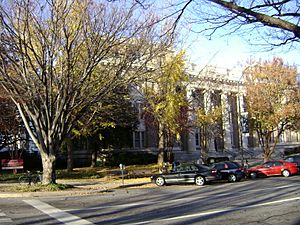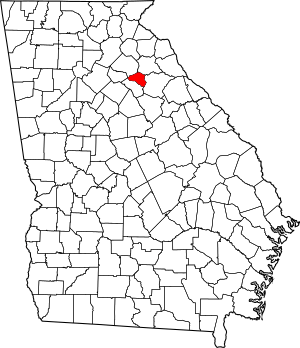Clarke County, Georgia facts for kids
Quick facts for kids
Clarke County
|
||
|---|---|---|

Clarke County Courthouse in Athens
|
||
|
||

Location within the U.S. state of Georgia
|
||
 Georgia's location within the U.S. |
||
| Country | ||
| State | ||
| Founded | 1801 | |
| Named for | Elijah Clarke | |
| Seat | Athens | |
| Largest city | Athens | |
| Area | ||
| • Total | 121 sq mi (310 km2) | |
| • Land | 119 sq mi (310 km2) | |
| • Water | 1.8 sq mi (5 km2) 1.5%% | |
| Population
(2020)
|
||
| • Total | 128,671 | |
| • Estimate
(2023)
|
129,933 |
|
| • Density | 1,063/sq mi (410.6/km2) | |
| Time zone | UTC−5 (Eastern) | |
| • Summer (DST) | UTC−4 (EDT) | |
| Congressional districts | 9th, 10th | |
Clarke County is a special place in the northeastern part of the U.S. state of Georgia. It's known for being a consolidated city-county, which means its main city, Athens, and the county government work together as one. In 2020, about 128,671 people lived here. Clarke County is part of a larger area called the Athens-Clarke County Metropolitan Statistical Area.
Contents
History of Clarke County
How Clarke County Was Formed
Clarke County was officially created on December 5, 1801. This happened because the Georgia General Assembly (Georgia's law-making group) passed a special act. The county was named after Elijah Clarke, a brave hero from the American Revolutionary War. It was first made up of about 250 square miles that used to be part of Jackson County. Colonel Clarke was very important in a big victory called the Battle of Kettle Creek in 1779. There's even a monument in Athens to remember him.
Early Growth and Industries
As more people moved to Clarke County in the early 1800s, farming and the cotton industry grew a lot. Crops from nearby farms were processed in the city's mills. Making things (manufacturing) and producing textiles (like cloth) became the main jobs. This was especially true after the railroad arrived in Athens in 1841. In the 1840s, Athens and Clarke County had the second-highest amount of money invested in manufacturing in Georgia. Only Savannah and Chatham County had more.
Clarke County During the Civil War
During the American Civil War in 1864, two small fights happened in Clarke County. One was near Barber's Creek, and another was close to Mitchell's Road. The Union Army took control of Athens on May 29, 1864. A military leader was put in charge. The official military control of the county ended by December 1864. However, Union troops stayed in the county until early 1866.
Changes to the County Seat
In 1801, the Clarke County Commission chose Watkinsville as the county seat. This meant it was where the county government offices were located. But on November 24, 1871, all county offices, including the courts and jail, moved to Athens. County meetings were held in the old Athens town hall until a new courthouse was built in 1876. The courthouse used today was built in 1914.
On February 12, 1875, some people were unhappy about the county seat moving to Athens. So, the state legislature created Oconee County from the southwestern part of Clarke County. Watkinsville became the seat of this new county. Because of this, Clarke County lost about one-third of its people and three-fifths of its land.
Modern County Government
The state legislature created a role called "commissioner of roads and revenue." Today, these people are known as county commissioners. They help the county manage programs for health and welfare. They also build and take care of roads, and they oversee the courts.
On March 29, 1973, the Georgia legislature made a change. They increased the number of county commissioners from 3 to 5. They also added a county administrator to help run things.
In 1990, the people living in Clarke County voted for a big change. They decided to combine the city and county governments. This created Athens-Clarke County. It was the second time a city and county government joined together in Georgia. The first was Columbus-Muscogee County.
Geography of Clarke County
Clarke County is located in the Piedmont region of Georgia. This area is known for its rolling hills. The exact center of the county is around 33°57′20″N 83°23′00″W / 33.955464°N 83.383245°W.
Most of Clarke County is in the Upper Oconee River area. This river flows into the larger Altamaha River. A very small part of the county's eastern side, near Winterville, is in the Broad River area, which flows into the Savannah River.
The U.S. Census Bureau says Clarke County has a total area of about 121 square miles. Out of this, 119 square miles is land, and 1.8 square miles (1.5%) is water. It is the smallest county in Georgia by land area.
Neighboring Counties
Clarke County shares its borders with several other counties:
- Madison County, Georgia - to the northeast
- Oglethorpe County, Georgia - to the east
- Oconee County, Georgia - to the southwest
- Barrow County, Georgia - to the west
- Jackson County, Georgia - to the northwest
Communities in Clarke County
Cities
- Athens (This is the county seat, where the main government offices are)
- Winterville
Town
- Bogart (Most of this town is actually in Oconee County)
Population of Clarke County
| Historical population | |||
|---|---|---|---|
| Census | Pop. | %± | |
| 1810 | 7,628 | — | |
| 1820 | 8,767 | 14.9% | |
| 1830 | 10,176 | 16.1% | |
| 1840 | 10,522 | 3.4% | |
| 1850 | 11,119 | 5.7% | |
| 1860 | 11,218 | 0.9% | |
| 1870 | 12,941 | 15.4% | |
| 1880 | 11,702 | −9.6% | |
| 1890 | 15,186 | 29.8% | |
| 1900 | 17,708 | 16.6% | |
| 1910 | 23,273 | 31.4% | |
| 1920 | 26,111 | 12.2% | |
| 1930 | 25,613 | −1.9% | |
| 1940 | 28,398 | 10.9% | |
| 1950 | 36,550 | 28.7% | |
| 1960 | 45,363 | 24.1% | |
| 1970 | 65,177 | 43.7% | |
| 1980 | 74,498 | 14.3% | |
| 1990 | 87,594 | 17.6% | |
| 2000 | 101,489 | 15.9% | |
| 2010 | 116,714 | 15.0% | |
| 2020 | 128,671 | 10.2% | |
| 2023 (est.) | 129,933 | 11.3% | |
| U.S. Decennial Census 1790-1880 1890-1910 1920-1930 1930-1940 1940-1950 1960-1980 1980-2000 2010 2020 |
|||
| Race / Ethnicity (NH = Non-Hispanic) | Pop 2000 | Pop 2010 | Pop 2020 | % 2000 | % 2010 | % 2020 |
|---|---|---|---|---|---|---|
| White alone (NH) | 62,895 | 66,674 | 72,201 | 61.97% | 57.13% | 56.11% |
| Black or African American alone (NH) | 27,496 | 30,695 | 31,367 | 27.09% | 26.30% | 24.38% |
| Native American or Alaska Native alone (NH) | 164 | 141 | 297 | 0.16% | 0.12% | 0.23% |
| Asian alone (NH) | 3,162 | 4,811 | 4,920 | 3.12% | 4.12% | 3.82% |
| Pacific Islander alone (NH) | 41 | 48 | 66 | 0.04% | 0.04% | 0.05% |
| Other race alone (NH) | 172 | 270 | 980 | 0.17% | 0.23% | 0.76% |
| Mixed race or Multiracial (NH) | 1,123 | 1,883 | 4,504 | 1.11% | 1.61% | 3.50% |
| Hispanic or Latino (any race) | 6,436 | 12,192 | 14,336 | 6.34% | 10.45% | 11.14% |
| Total | 101,489 | 116,714 | 128,671 | 100.00% | 100.00% | 100.00% |
As of the 2020 United States census, there were 128,671 people living in Clarke County. These people lived in 52,124 households, and 24,041 of these were families.
Education in Clarke County
To learn more about schools and learning opportunities in Clarke County, you can check out the main article about education in Athens.
Transportation in Clarke County
Major Roads and Highways
Many important roads run through Clarke County, making it easy to travel around.
Paths for Walking and Biking
Clarke County also has great paths for people who enjoy walking or riding bikes.
- Athens North Oconee River Greenway
- Firefly Trail
See also
 In Spanish: Condado de Clarke (Georgia) para niños
In Spanish: Condado de Clarke (Georgia) para niños



